0
Table of Content
Table of Contents
Chapter 1: Virtual Private Cloud - VPC 1
VPC 1
VPC Introduction 1
The Structure of Availability Zone 2
Create VPC - AWS Console 4
Select Region 4
Create VPC 7
DHCP Options Set 9
Main Route Table 10
VPC Verification Using AWS CLI 12
Create VPC - AWS CloudFormation 16
Create Template 17
Uppload Template 17
Verification Using AWS Console 18
VPC Verification using AWS CLI 21
Create Subnets - AWS Console 23
Create Subnets 24
Route Tables 29
Create Subnets – AWS Console 30
Create Subnets - AWS CloudFormation 37
Create Network ACL 40
Chapter 2: VPC Control-Plane 43
VPC Control-Plane – Mapping Service 43
Introduction 43
Mapping Register 43
Mapping Request - Reply 44
Data-Plane Operation 45
References 46
Chapter 3: VPC Internet Gateway Service 47
Introduction 47
Allow Internet Access from Subnet 48
Create Internet Gateway 49
Update Subnet Route Table 54
Network Access Control List 57
Associate SG and Elastic-IP with EC2 59
Create Security Group 59
Launch an EC2 Instance 65
Allocate Elastic IP address from Amazon Ipv4 Pool 71
Reachability Analyzer 81
Billing 85
Chapter 4: VPC NAT Gateway 87
Introduction 87
Create NAT Gateway and Allocate Continue reading

